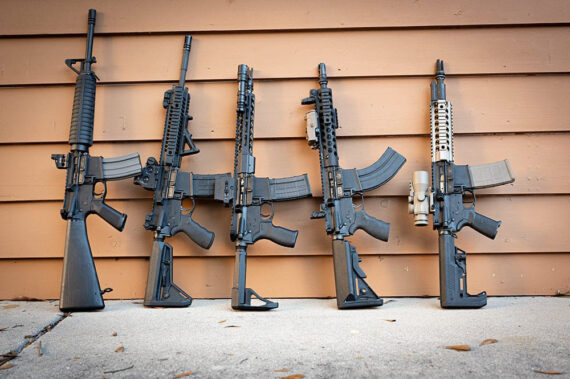All About AR-15 Barrel Lengths
When they tested the 5.56×45 round back in the 50s, it was done so using 20-inch barrels. While it does reasonably well in any barrel length, it really thrives in some and performs poorly in others.
For example, too short of a barrel can cause you to throw flames due to unburnt powder. While it may seem cool, it could give your position away. And it doesn’t hit as hard when shot out of shorter barrels.
This was a massive issue with door kickers overseas. The enemy was often on drugs, and the 5.56×45 round out of a 10.5-12.5-inch barrel was too little to put them down with one or two shots. It took a few.
Once you get Special Forces guys complaining, things tend to change fast. That’s why the .300 Blackout round was created.
Understanding that barrel length can play such an important factor in your rifle’s overall performance, it’s essential to consider which length will work best for your intended use(s).
All different shapes and sizes. Source: mtstate.org
Why Does Barrel Length Matter?
As we alluded to above, the 5.56×45 round performs best out of longer barrels. When you start chopping off length from your barrel, you start losing velocity and muzzle energy quickly.
The best way to get the most out of your AR-15 is to use a 16-inch barrel. That’s just enough for you to take full advantage of the 5.56×45 cartridge while not having an unwieldy rifle.
While this may not matter for most of us since we aren’t kicking down doors, it’s valuable knowledge for someone building a rifle or trying to get more out of their AR-15.
Barrel Lengths
Depending on what you’re planning to use your rifle for, whether home defense or competition, the barrel length can play a large role in your success.
Most AR-15s you see on the market will come with a 16-inch barrel. At that length, you are getting almost optimal results from the round. However, sixteen inches can be too long for home defense applications if you have a lot of tight corners and spaces in your home.
That’s where you find barrel lengths of 10.5-13.7 inches do best. You’ll want to go on the shorter side if you plan on running a suppressor on your home defense gun, which I recommend.
But that same 10.5-12.5-inch barrel can be too short in certain scenarios. If SHTF, many engagements happen at longer distances, where a longer barrel will be a better choice.
Then we have 13.7-14.5-inch barrels. These versatile barrel lengths still give you enough barrel to optimize the performance of the 5.56×45 but are still compact enough to maneuver around corners easily.
A table to help you remember. Source: Pinterest
Velocity Chart
Make sure to pay close attention to how quickly velocity, pressure, and effective range change with even a small change in barrel length.
| Barrel Length | Bullet Velocity | Pressure | Estimated Maximum Effective Range |
| 5.5″ | 1,780 | 24,000psi | 50-100 Yards |
| 7” | 2,330 | 17,040psi | 100-150 Yards |
| 9” | 2,400 | 13,565psi | 150-175 Yards |
| 11” | 2,570 | 10,540psi | 175-200 Yards |
| 13” | 2,645 | 8,885psi | 250-300 Yards |
| 16” | 2,800 | 7,430psi | 500 Yards |
| 18” | 3,050 | 6,313psi | 600-650 Yards |
| 20” | 3,100 | 5,717psi |
700-800 Yards |
Twist Rates
Within each barrel length, there can be varying twist rates.
Here is an example.
1:8 Twist Rate
1 = One 360-degree twist of the bullet
8 = Every 8 Inches
1:8 = 1 360 twist of the bullet every 8 inches of barrel.
Another example.
1:10 Twist Rate
1 = One 360-degree twist of the bullet
10 = Every 10 inches
1:10 = One 360 twist of the bullet every 10 inches of the barrel.
So, if you have a 16-inch barrel with a 1:8 twist, the round will make two complete revolutions before it leaves the barrel.
Think of it like throwing a football. More spins typically mean better accuracy. Source: hunter-ed.com
How It Affects Accuracy
Rifling was first introduced in 1498 by Augustus Kotter but, for some reason, didn’t find its way to American rifles until the 1840s and 1850s. Until then, smoothbore rifles dominated the market.
Now, we have it narrowed down to a science. The shorter the twist rate, the faster the bullet goes. But, if it spins too fast, it can destabilize the round, causing accuracy issues.
These days, you’ll almost always find that the manufacturers include a twist rate appropriate for the barrel length. Otherwise, they could be setting themselves up for failure and returns.
Yes, some manufacturers make specialty barrels with shorter twist rates on longer barrels for stabilizing heavy rounds, but they understand that most of us will be shooting 55-grain M193.
In that case, many of us will benefit from a 1:8 twist. It’s a sweet middle ground that allows you to shoot several different ammo weights without realizing many issues.
Conclusion
The beautiful thing about the AR-15 is how modular it is. You can order as many upper receivers as you want, and as long as they are compatible with the lower receiver you have, there is no need to visit your FFL.
Then, say you want a 10.5-inch AR-15 and a 16-inch AR-15; you can simply buy two different uppers and swap them when you’d like.
If you’re unsure of what barrel length to go with, I usually suggest a 13.7-14.5 inch one to get you started. These versatile barrel lengths tackle almost any task. As long as you aren’t trying to reach out to 1,000+ yards. Then, that’s a different story.
At the end of the day, you should consider your rifle’s intended purpose and go with the barrel length that makes the most sense.
Be good and take care.


